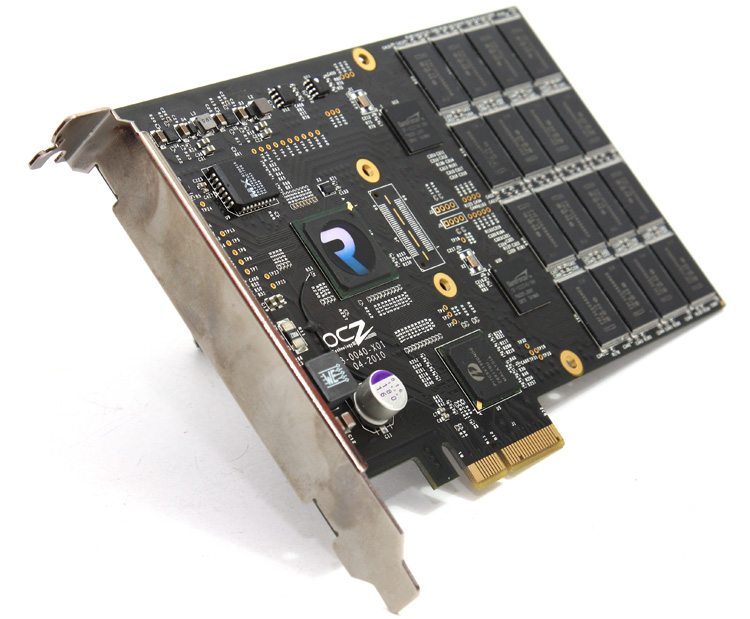Specifications and Features
So the RevoDrive we'll be testing today is a 120GB version. Here's how that works. OCZ places two NAND flash partitions onto a PCB. Each 64GB partition will get a SandForce 1200 based IC assigned for multi-channel IO. Then controlling the two SandForce ICs is a SiS RAID controller, model 3124 SoftRaid 5. It will assign two SATA II channels, one to each "SSD partition". These two partitions will be then setup in RAID0 (Stripe) effectively doubling up performance, in theory. All that data requires bandwidth. So OCZ opted to run it over the PCIe bus. However, one PCIe x1 slot would already limit the available bandwidth. A bridge chip on it's end then connects to the motherboard chipset via x4 lanes of PCIe 1.0, that provides as much as 1 GB/s of bandwidth of throughput.
Performance Specifications
- Max Read: 540 MB/s
- Max Write: 480 MB/s
- 4KB Random Write (QD32, 4K Aligned): 75,000 IOPS
Key Features
- Designed to be the most affordable and accessible PCI-Express SSD
- SATA (3Gb/s) bottleneck no longer an issue
- Bootable (unlike competing solutions) so users can enjoy enhanced OS performance
- Implements SandForce 1200 Controller with Max IOPS Firmware
- Out-of-the-box solution, no need to purchase a RAID controller.
- Cost-effective 34nm MLC flash with enhanced reliability
MSRP
- 120G @ $369.99
- 240G @ $674.99
Let's talk SandForce first - The SSD partitions utilizes SandForce's latest version of the SF-1200 controller, widely adopted by other players in the market as well, e.g. Corsair, ADATA and OCZ on their SSDs. The controller adds support for newer NAND memory types as in 34nm memory. New 34nm NAND Flash memory is cheaper to manufacture, thus cheaper for companies to implement, and for you as a consumer cheaper to purchase.
The read and write speeds for most SF1200 models are advertised at a blazing 285 MB/sec read and 275MB/sec write performance (measured with ATTO test software), which makes the product position itself in the extreme high-end SSD segment.
Typically however we see the competitive Indilinx Barefoot controller paired with 64MB of Elpida cache memory in the latest SSDs. SandForce however does not need that cache memory. Sandforce uses a complex real-time data compression, saving on cache needs. Enabling it to write random I/O extremely fast, it instead hogs some of the NAND FLASH memory to use as cache. To manage all the multi-channel controller loving embedded into the controller we see a tiny processor inside the controller, and next to it a small NAND memory cache.
Why is that a so important thing to that random I/O you ask. Well, history learned us the hard way that most budget SSDs had a 1st generation JMicron controller with very little cache (8KB / 16KB), and the issue there is that if they need to write a lot of really small files simultaneously these drives started to choke up every now and then, your a-typical data bottleneck within a storage unit. Large data-caches solve that issue very well. So a big help totally bypassing the small files issue for SSD drives is using a nice big mamma SDRAM buffer, or the approach that SandForce takes should be more than sufficient as well.
So the OCZ RevoDrive virtually has two of these SandForce SSDs mounted onto this PCIe card.
Put even more simple, this PCIe x4 card takes a duo of SF-1200 controllers and RAIDs them together, giving you roughly the performance of two SF-1200 SSDs but on a single card. All that of a price lower than two SandForce 120GB SSDs.
OCZ - Moving beyond the bottleneck of SATA II (3Gbps), the OCZ RevoDrive features a PCIe interface to deliver superior speeds over 500MB/s reads and random small file writes up to 80,000 IOPS, nearly twice the speed of other consumer SSDs. Thanks to a proprietary RAID 0 design, the RevoDrive maximizes data access and bandwidth to promote a faster, more responsive PC experience compared to not only hard drives, but other SSDs on the market.
The RevoDrive is the first PCIe SSD that delivers both performance and affordability and radically alters the SSD landscape, said Ryan Petersen, CEO of the OCZ Technology Group. Up to this point PCIe SSDs have been reserved for enterprise applications and priced out of the range of many consumers, the bootable RevoDrive SSD changes the game by delivering a PCIe based solution that costs as low as $3 per gigabyte, exceptional small file write IOPS of over 80K, which is the most available in any low-cost solution.
Unlike competing PCIe solutions, the RevoDrive is bootable, ensuring the satisfaction of quicker boot-ups, load times, and computing, all while promoting cooler, quieter, and more energy efficient conditions compared to traditional mechanical hard drives.
Offering ample storage for the latest operating systems, game titles, and applications, the OCZ RevoDrive will be initially available in 120GB and 240GB capacities, with MSRPs of $389.99 and $699.99.
The good thing is, this card will function as a full drive, this means it is bootable, you can install Windows on it (during the installation simply install the RevoDrive driver (OS will ask you this) and boom, you are good to go. All major Windows OSes are compatible, including XP, Vista and 7 in with 32-bit and 64-bit drivers.
The one deficit we need to mention though is that the SIS RAID controller does not support the TRIM function, so over time performance will degrade somewhat. However with the controllers being SandForce based (horrendously fast Random IO) that will be compensated, the overall performance should be no different than a pair of SF-1200s in RAID (on a good controller/chipset).
Anyway enough tech chatter, let's have a look at the product ....

